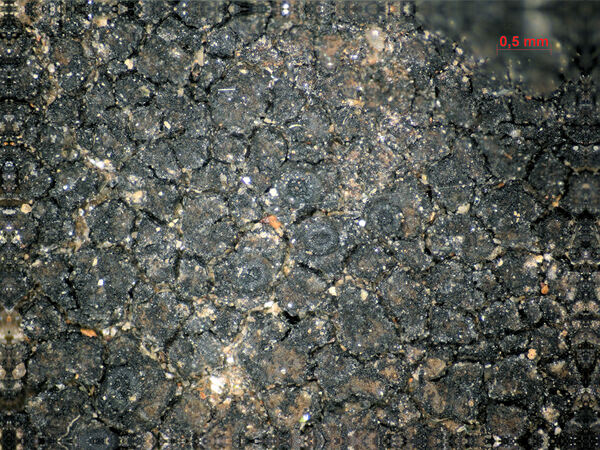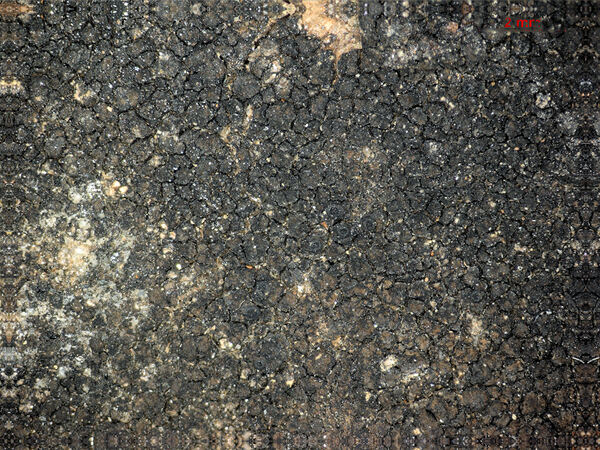Rinodina zwackhiana (Kremp.) Körb.
Syst. Lich. Germ.: 126, 1855. Basionym: Lecanora zwackhiana Kremp. - Flora, 37: 145, 1854.
Synonyms: Johnsheardia zwackhiana (Kremp.) S.Y. Kondr., Kärnefelt & A. Thell; Rinodina murorum B. de Lesd.; Rinodina transsylvanica (Nyl.) H. Olivier; Rinodina violascens H. Magn.
Distribution: N - Lig.
Description: Thallus crustose to subsquamulose, episubstratic, thick, of convex areoles, sometimes sublobate at margins, brown, more rarely ochraceous or dark grey, esorediate or with soredia developing on upturned areole margins (mainly on thalli lacking apothecia). Cortex paraplectenchymatous; medulla white, I-. Apothecia lecanorine, adnate, often contiguous, (0.3-)0.5-1 mm across, usually one per areole, with a dark brown to black, persistently flat disc and a thin, entire and persistent thalline margin. Thalline exciple 90-160 µm wide laterally, the cortex 10-20 µm thick, with an epinecral layer; proper exciple colourless, 10-20 µm wide, expanding to 40-50 µm in upper part, the outermost portion K+, N+ pink or violet: epithecium bluish grey, K+, N+ pink or violet; hymenium colourless, 120-140 µm high, inspersed with oil droplets; paraphyses not strongly coherent, 1.5-2.5 µm thick at mid-level, the apical cells 3-4.5 µm wide, lightly pigmented; hypothecium colourless, sometimes extended into a sort of stipe, 120-190 µm high. Asci 8-spored, clavate, the K/I+ blue tholus penetrated by a faintly amyloid apical cushion with parallel or diverging flanks, the wall K/I-, surrounded by a K/I+ blue outer layer, Lecanora-type. Ascospores 1-septate, brown, broadly ellipsoid, (15.5-)18.5-20.5(23.5) x (9.5-)11-12.5(-14) µm, similar to the Bicincta-type but without the typical dark bands, the lumina mostly rounded, the lateral wall expanded at septum when young, the septum strongly pigmented at maturity. Photobiont chlorococcoid. Spot tests: K-, C-, KC-, P-, UV-. Chemistry: without lichen substances.Note: a mainly mild-temperate lichen found on steeply inclined to slightly rain-sheltered surfaces of calcareous rocks, on walls, sometimes a juvenile parasite on other lichens; probably more widespread and much overlooked.
Growth form: Crustose
Substrata: rocks
Photobiont: green algae other than Trentepohlia
Reproductive strategy: mainly sexual
Commonnes-rarity: (info)
Alpine belt: absent
Subalpine belt: absent
Oromediterranean belt: absent
Montane belt: absent
Submediterranean belt: absent
Padanian area: absent
Humid submediterranean belt: rare
Humid mediterranean belt: very rare
Dry mediterranean belt: absent

Predictive model

Lucia Muggia CC BY-SA 4.0; Owner: Department of Life Sciences, University of Trieste
Herbarium: GZU (10-94 leg.Poelt et al. 1994)

Lucia Muggia CC BY-SA 4.0; Owner: Department of Life Sciences, University of Trieste
Herbarium: GZU (10-94, 1994, Leg. J. Poelt et al.)
Growth form: Crustose
Substrata: rocks
Photobiont: green algae other than Trentepohlia
Reproductive strategy: mainly sexual
Commonnes-rarity: (info)
Alpine belt: absent
Subalpine belt: absent
Oromediterranean belt: absent
Montane belt: absent
Submediterranean belt: absent
Padanian area: absent
Humid submediterranean belt: rare
Humid mediterranean belt: very rare
Dry mediterranean belt: absent

Predictive model

Lucia Muggia CC BY-SA 4.0; Owner: Department of Life Sciences, University of Trieste
Herbarium: GZU (10-94 leg.Poelt et al. 1994)

 INDEX FUNGORUM
INDEX FUNGORUM
 GBIF
GBIF



